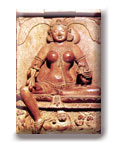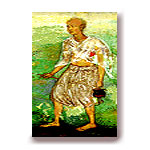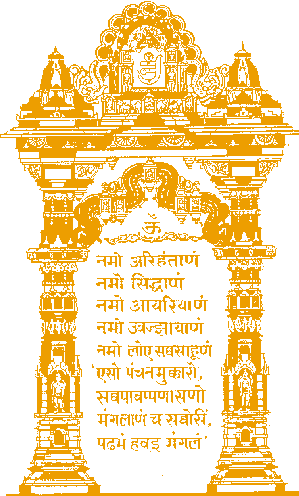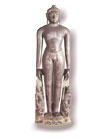Philosophy of Religion
Chapter 2. Religions of the World
Section 3 . Jainism





· THE ABSOLUTE: what do the believers hold as most important? What is the ultimate source of value and significance? For many, but not all religions, this is given some form of agency and portrayed as a deity (deities). It might be a concept or ideal as well as a figure.
· THE WORLD: What does the belief system say about the world? Its origin? its relation to the Absolute? Its future?
· HUMANS: Where do they come from? How do they fit into the general scheme of things? What is their destiny or future?
· THE PROBLEM FOR HUMANS: What is the principle problem for humans that they must learn to deal with and solve?
· THE SOLUTION FOR HUMANS: How are humans to solve or overcome the fundamental problems ?
· COMMUNITY AND ETHICS: What is the moral code as promulgated by the religion? What is the idea of community and how humans are to live with one another?
· AN INTERPRETATION OF HISTORY: Does the religion offer an explanation for events occurring in time? Is there a single linear history with time coming to an end or does time recycle? Is there a plan working itself out in time and detectable in the events of history?
· RITUALS AND SYMBOLS: What are the major rituals, holy days, garments, ceremonies and symbols?
· LIFE AFTER DEATH: What is the explanation given for what occurs after death? Does he religion support a belief in souls or spirits which survive the death of the body? What is the belief in what occurs afterwards? Is there a resurrection of the body? Reincarnation? Dissolution? Extinction?
·
RELATIONSHIP TO OTHER
RELIGIONS: What is the prescribed manner in which believers are to regard
other religions and the followers of other religions?
**********************************************************
For those who wish to listen to information on the world's
religions here is a listing of PODCASTS on RELIGIONS by Cynthia
Eller.
************************************************************
If you have iTunes on your computer just click and you will be led to the
listings.
http://phobos.apple.com/WebObjects/MZStore.woa/wa/viewPodcast?id=117762189&s=143441
Here is a link to the site for the textbook REVEALING WORLD RELIGIONS
related to which these podcasts were made.
http://thinkingstrings.com/Product/WR/index.html
|
THE TEACHINGS OF LORD MAHAVIRA
Lord Mahavira was born on March 30, 599 B.C. and attained the nirvana in the year 527 B.C. at the age of 72. He was a contemporary of Lord Buddha. He was the 24th and the last of the Tirthankars. The present form of Jainism was shaped by him.
The cardinal principles of Jainism are:
1. Ahimsa (non-violence)
2. Anekantvada (multiplicity of views)
3. Aparigraha (non-possessiveness)
4. Non-stealing
5. Brahmacharya
The first and the third are quite simple to understand but the second one needs some explanation. It is dealt under 'Multiplicity of Viewpoints and Relativism (Syadavada)', in the Jain literature. Difference of view points, quite often, add to the knowledge and one should infer, only after hearing diverse views on any subject. If it is not done, then the conclusions
reached could be biased or incorrect. It provides for the tolerance for the views of the others. One can have a better perception only after hearing others. For example, we are all familiar with the story of the eight blind men and an elephant. There the views expressed about the elephant by each of the blind men were correct but only partial knowledge could be obtained from any one view. The total knowledge about the elephant could be had only by listening to all of them.
An object can, on occasions, be described by two completely opposite statements, i.e. it is (ASTI) and it is not (NASTI). These two statements can be made referring to (1) substance, (2) place, (3) time, and (4) form. Let us take an example of a piece of furniture. A piece of furniture made of jungle wood is not made of sandal wood. Similarly, it could be located in a given room but not in other rooms. Thus, it can be specified in either way which seem to be opposite to each other. This way of specification is called ASTI - NASTI - VADA.
Another set of logic lines has been developed by the Jain thinkers which postulate that there can be as many as seven modes of prediction in a given case. This introduces an element of uncertainty in the predictions and therefore introduces the concept of probability. This is called Syadavada or the doctrine of `may be '.
If we consider the Jainist and the Vedantic philosophies, we will find that both are correct in their own ways. They do not contradict each other. The Jain philosophy does not go into the depth of the process of creation as does the Vedantism and therefore it ( Vedantism ) arrives at the conclusion of The God as the First Cause. On the other hand, the Jainism comes up with the understanding of the complexity of the universe for the common humans and proposes the Syadavada which is a marvellous concept of accommodation which is necessary for the correct evaluation of anything. The Jainism defines life in almost everything, and therefore, preaches non-violence of extreme degree.
In summary, the Jains consider the highest ideal - Tirthankara who possesses infinite knowledge, infinite bliss and infinite power. This blissful state is similar to that of Vedantic `Chitananda'. Jainism makes distinction between Arhat and Siddha which are analogous to the Vedantic Jivan Mukta (free form life) and Videha Mukta ( free from body ). A Jivan Mukta might also be a Videha Mukta as in the case of King Janaka. Tirthankaras are those Siddhas who profound the truth during their life time which is a higher thing. The Jains have Arhats, the Siddhas, and the Tirthankaras who in the simpler terms and in the corresponding manner are: those who deserve, those who accomplish, and those who sanctify. It is possible for every man to attain the highest state. Tirthankaras take the place of God in the Jain philosophy
Jainism begins with a serious concern for the human soul in its relationship with the laws governing existence in the universe,with other living beings, and to its own future state in eternity. First and foremost, it is a religion of the heart: the golden rule is Ahimsa or nonviolence in all parts of a person-- mental,verbal, and physical. Jains have deep compassion for all forms of life
Jainism offers a quiet, overwhelmingly serious way of life, a cultural insistence on compassion, a society of ethics that has dramatically changed the world and will continue to effect change. Jainism is an ecologically responsible way of life which is nonviolent in thought, action, and deed.
Jina and the Soul
The "Jains" are the followers of the Jinas. "Jina" literally means "Conqueror." He who has conquered love and hate, pleasure and pain, attachment and aversion, and has thereby freed `his' soul from the karmas obscuring knowledge, perception, truth, and ability, is a Jina. The Jains refer to the Jina as God.
Origins of Jainism
Originating on the Indian subcontinent, Jainism -- or, more properly, the Jain Dharma -- is one of the oldest religions of its homeland and indeed of the world. Jainism has prehistoric origins dating before 3000 BC, and before the beginning of Indo-Aryan culture.
Jain religion is unique in that, during its existence of over 5000 years, it has never compromised on the concept of nonviolence either in principle or practice. It upholds nonviolence as the supreme religion (Ahimsa Paramo Dharmah) and has insisted upon its observance in thought, word, and deed at the individual as well as social levels. The holy text Tattvartha Sutra sums it up in the phrase "Parasparopagraho Jivanam" (all life is mutually supportive). Jain religion presents a truly enlightened perspective of equality of souls, irrespective of differing physical forms, ranging from human beings to animals and microscopic living organisms. Humans, alone among living beings, are endowed with all the six senses of seeing, hearing, tasting smelling, touching, and thinking; thus humans are expected to act responsibly towards all life by being compassionate, egoless,fearless, forgiving, and rational.
The Jain Code of Conduct
In short, the code of conduct is made up of the following five vows, and all of their logical conclusions: Ahimsa, Satya (truthfulness), Asteya (non-stealing), Aparigraha (non-possessiveness), and Brahmacharya (chastity). Jain religion focuses much attention on Aparigraha, non-possessiveness towards material things through self-control, self-imposed penance, abstinence from over-indulgence, voluntary curtailment of one's needs, and the consequent subsiding of the aggressive urge.
Vegetarianism
Vegetarianism is a way of life for a Jain, taking its origin in the concept of compassion for living beings, Jiva Daya. The practice of vegetarianism is seen as an instrument for the practice of nonviolence and peaceful, cooperative coexistence. Jains are strict vegetarians, consuming only one-sensed beings, primarily from the plant kingdom. While the Jain diet does, of course, involve harm to plants, it is regarded as a means of survival which involves the bare minimum amount of violence towards living beings. (Many forms of plant material, including roots and certain fruits, are also excluded from the Jain diet due to the greater number of living beings they contain owing to the environment in which they develop.)
I. Introduction
Jainism, religion of India concentrated largely in Gujarat and Rajasthan, in parts of Mumbai (formerly Bombay), and in the state of Karnataka (Mysore), as well as in the larger cities of the Indian peninsula. The Jains totaled about 3.7 million as the 1990s began, but they exert an influence in the predominantly Hindu community far out of proportion to their numbers; they are mainly traders, and their wealth and authority have made their comparatively small sect one of the most important of living Indian religions.
II. Origins
Jainism is somewhat similar to Buddhism, of which it was an important rival in India. It was founded by Vardhamana Jnatiputra or Nataputta Mahavira (599-527 BC), called Jina (Spiritual Conqueror), a contemporary of Buddha. As do the Buddhists, the Jains deny the divine origin and authority of the Veda and revere certain saints, preachers of Jain doctrine from the remote past, whom they call tirthankaras ("prophets or founders of the path"). These saints are liberated souls who were once in bondage but became free, perfect, and blissful through their own efforts; they offer salvation from the ocean of phenomenal existence and the cycle of rebirths. Mahavira is believed to have been the 24th tirthankara. Like adherents to their parent sect, Brahmanism, the Jains admit in practice the institution of caste, perform a group of 16 essential rites, called samskaras, prescribed for the first three varna (castes) of Hindus, and recognize some of the minor deities of the Hindu pantheon; nevertheless, their religion, like Buddhism, is essentially atheistic.
Fundamental to Jainism is the doctrine of two eternal, coexisting, independent categories known as jiva (animate, living soul: the enjoyer) and ajiva (inanimate, nonliving object: the enjoyed). Jains believe, moreover, that the actions of mind, speech, and body produce subtle karma (infraatomic particles of matter), which become the cause of bondage, and that one must eschew violence to avoid giving hurt to life. The cause of the embodiment of the soul is thought to be karmic matter; one can attain salvation (moksha) only by freeing the soul of karma through the practice of the three "jewels" of right faith, right knowledge and right conduct.
III. Differences in Doctrine
These principles are common to all, but differences occur in the religious obligations of the monastic orders (whose members are called yatis) and the laity (sravakas). The yatis must observe five great vows (panca-mahavrata): refusal to inflict injury (ahimsa), truthfulness (satya), refusal to steal (asteya), sexual restraint (brahmacarya), and refusal to accept unnecessary gifts (aparigraha). In keeping with the doctrine of nonviolence, they carry the Jainist reverence for animal life to its most extreme lengths; the yati of the Svetambara sect, for example, wears a cloth over his mouth to prevent insects from flying into it and carries a brush to sweep the place on which he is about to sit, to remove any living creature from danger. The observation of the nonviolent practices of the yatis was a major influence on the philosophy of the Indian nationalist leader Mohandas Gandhi. The secular sravaka, in addition to his observance of religious and moral duties, must engage in the adoration of the saints and of his more pious brethren, the yatis.
The two main sects of Jainism, the Digambara (space-clad, or naked) and the Svetambara (white-clad, wearers of white cloth), have produced a vast body of secular and religious literature in the Prakrit and Sanskrit languages. The art of the Jains, consisting primarily of cave temples elaborately decorated in carved stones and of illustrated manuscripts, usually follows Buddhist models but has a richness and fertility that mark it as one of the peaks of Indian art. Some sects, particularly the Dhundia and the Lunka, which reject the worship of images, were responsible for the destruction of many works of art in the 12th century, and Muslim raids were responsible for the looting of many temples in northern India. In the 18th century another important sect of Jainism was founded; it exhibited Islamic inspiration in its iconoclasm and rejection of temple worship. Complex rituals were abandoned in favor of austere places of worship called sthanakas, from which the sect is called Sthanakavasi.
| Special thanks to the Microsoft Corporation for their contribution to our site. The information above came from Microsoft Encarta. Here is a hyperlink to the Microsoft Encarta home page. http://www.encarta.msn.com |
Basic Listing of Sites
http://www.cs.colostate.edu/~malaiya/jainhlinks.html
Fundamentals
of Jainism
READ:
http://www.angelfire.com/co/jainism/
Introduction
to Jainism
http://www.theosophy-nw.org/theosnw/world/asia/reljain3.htm
http://www.beliefnet.com/index/index_10040.html
Overall
view of Jainism
http://www.engr.mun.ca/~asharan/bihar/jainism.html
http://arham.com/abt_jain_index.htm
Philosophy
of Jainism
http://www.jinvani.com/eng/philosophy/index.htm
Mahavira
and Jainism
http://www.san.beck.org/EC8-Mahavira.html
Glossary http://www.cs.colostate.edu/~malaiya/jaingloss.html
SACRED TEXTS
Proceed to the next section by clicking here> next
© Copyright Philip A. Pecorino 2001. All Rights reserved.
Web Surfer's Caveat: These are class notes, intended to comment on readings and amplify class discussion. They should be read as such. They are not intended for publication or general distribution.